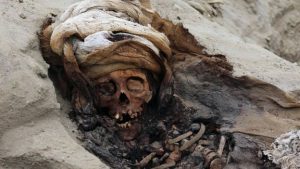Just north of Lima, Peru, around 140 bodies of children between the ages of five and 14 were discovered. Next to many of the children were around 200 llamas. The site of this archeological discovery is called “Huanchaquito-Las Llamas.” Stretching around 7,500 square feet, this site dates to about 1450 A.D., where the Chimú people lived, before the Inca nation invaded.

Above: One of the bodies found in Peru.
According to John Verano, an anthropologist at Tulane University, the site was a sacrifice in order to stop the rains, flooding, and mudflows that were being caused by the El Niño storm. In 2011, the leader of the study, Dr. Gabriel Prieto was approached by a man who told him that his children and the dogs in the area had been digging up bones. Prieto went to look at the site and assumed it to be a forgotten group cemetary, however he placed a call to Katya Valladares, who investigated the wounds on the bodies of the children. All of the children had the same cut on their sternum, which showed that the deaths of the children were not an accident. The bodies varied in appearance, and according to the article, “some bodies had been buried in cloth, some wore cotton headdresses, and others had red-cinnabar paint preserved on their skulls.” (St Fleur 2019).The sacrifice was not gender specific, as some of the bodies were identified as females, and others as males. Because of the storm, there was a thick layer of mud surrounding the sand in which the bodies were encased. It is believed that the weather “would have devastated the Chimú state, flooding crops, killing fish and sweeping people away.” (St Fleur 2019).
The information presented in these articles were strictly fact. The articles took the information, and provided a small historical background so that the readers were able to understand the situation better. The headlines of the articles directly tied into the stories and did not paint the Chimú people, or anybody who was involved in this archaeological discovery in a negative light. The portrayal of Peru, and of the indigenous people who live there, was very respectful.
“Mass Child Sacrifice Discovery May Be Largest in Peru.” BBC, August 28, 2019. https://www.bbc.com/news/world-latin-america-49495167.
St Fleur, Nicholas. “Massacre of Children in Peru Might Have Been a Sacrifice to Stop Bad Weather Be.” The New York Times, March 6, 2019. https://www.nytimes.com/2019/03/06/science/peru-child-sacrifice.html.
